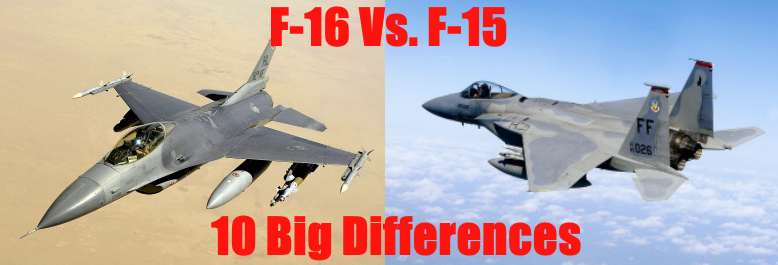The F-15 and F-16 are both fighter aircraft used by the United States Air Force and allied nations.
The F-15 is a dual-engine fighter jet that is capable of incredible speed and altitude, whereas the F-16 is a single-engine fighter aircraft with unprecedented maneuverability.
Though they have significant differences between them, both the F-15 and F-16 are superior aircraft, serving multiple roles in air combat and mission success.
Here are the top 10 differences between the F-15 and the F-16 aircraft.
Related Article – F-16 Vs. F-18: Top 10 Differences Between The Viper & Super Hornet
Table of Contents
#1. Speed, Range, Ceiling, Thrust
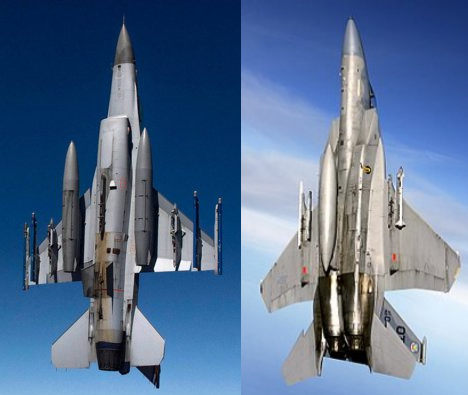
When it comes to speed, range, ceiling, and thrust, the F-15 is more powerful than the F-16.
Due to the thrust of the F-15 aircraft’s twin-engine design, it can accelerate while climbing at a 90-degree angle, managing 30,000 feet in 60 seconds.
The thrust of the F-15C/D models is 23,450 pounds for each engine.
Speed for the F-15 aircraft is Mach 2 class, at 1,875 mph.
F-15 fighters have a range of more than 3,450 miles ferry range, which is the equivalent of 3,000 nautical miles, with a ceiling of 65,000 feet.
The current F-16C/D models have a speed of 1,500 mph, which is Mach 2 at altitude.
The thrust of the F-16 is 27,000 pounds, which is less powerful than the F-15.
F-16 aircraft have a range of more than 2,002 miles ferry range, which is the equivalent of 1,740 nautical miles, with a ceiling above 50,000 feet.
#2. Design
Both the F-15 and F-16 use the same F100 jet engine by Pratt and Whitney.
These aircraft are also designed with the most reliable systems, based on cutting-edge aerospace science, for optimal performance and mission success.
F-15 Design
The F-15 is designed with a twin-engine configuration, twin-tail, and swept wing.
This allows it a tremendous amount of thrust, a high angle of attack, and stability at extremely high speeds.
The F-15E features two seats, designed as a multi-role, integrated fighter for all weather conditions, air-to-air, and deep interdiction missions.
The rear cockpit includes four multi-purpose CRT displays for managing the aircraft’s systems and weapons.
F-15 aircraft have digital Lear Siegler flight control systems that are triple-redundant and allow for automatic terrain following as well as a ring-laser gyro inertial navigation system.
To enhance precision at low altitudes and high speeds in adverse weather conditions or at night, the F-15 has a high-resolution APG-70 radar, low-altitude navigation, and targeting infrared.
The F-15 offers pilots a “heads-up” display.
This projects all essential flight information from the integrated avionics system on the windscreen.
Therefore, the display is visible in any condition and provides information so that the pilot does not have to look down at the cockpit instruments.
F-16 Design
The F-15, along with other aircraft, influenced the advanced aerospace systems that went into designing the F-16.
The goal was to simplify the airplane while reducing its size, purchase price, maintenance costs, and weight without compromising its strength.
The F-16 is designed as a single-tail and single-engine aircraft.
Its cockpit and “bubble” canopy provide unobstructed forward and upward vision for the pilot, in addition to improved vision to the side and rear.
The seat-back angle was expanded to 30 degrees, increasing F-16 pilots’ comfort and tolerance for G-force (gravity force).
In addition, the F-16’s “fly-by-wire” system allows for excellent control, as electrical wires relay pilot commands rather than cables and linkage controls.
F-16 pilots have easy and accurate control during combat maneuvers with a side-stick controller rather than a conventional center-mounted stick controller.
The hand pressure on the side-stick controller is what sends electrical signals to the actuators of flight control surfaces.
In addition, the F-16 is the first production aircraft that is designed with what is called “relaxed” (or negative) stability.
This differentiates the F-16 from other aircraft that are designed with positive stability, or the inclination to return to flying straight and level with no direction from the pilot.
Related Article – Army Reserves Vs. National Guard
#3. Maneuverability
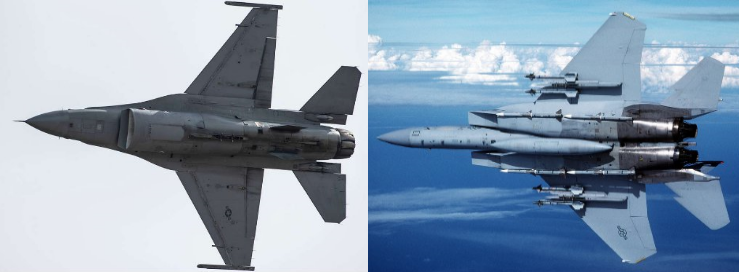
The F-16’s maneuverability and combat radius are superior among fighter aircraft.
The relaxed stability of the F-16 design allows for more efficient maneuvering.
This is because there is less energy loss since the airframe does not resist maneuvers and the computer on board helps to stabilize the aircraft.
Therefore, with full fuel, the F-16 can sustain 9-G (gravity force) maneuvers.
In addition, the F-16 can locate targets in all weather conditions and detect low-flying aircraft.
The maneuverability of the F-16 enhances its air-to-surface role as well in that it can accurately deliver ordnance in non-visual bombing conditions, defend itself against enemy aircraft, and return to its starting point.
The F-15 is also highly maneuverable due to its high engine thrust-to-weight ratio and low wing loading.
Wing-loading is the ratio of aircraft weight to its wing area.
These factors enhance the F-15’s maneuverability and enable it to make tight turns without losing airspeed.
#4. Cost
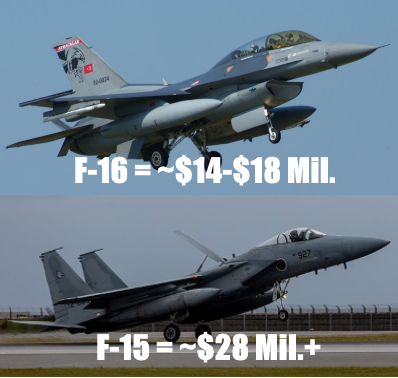
The F-16C/D costs about $18 million per unit.
The unit cost of F-16A/B is approximately $14 million.
This makes it a much cheaper aircraft to build and operate compared to the F-15.
Due to its high-performance design, the F-15C/D models cost about $30 million per unit.
The unit cost of F-15A/B is approximately $28 million.
#5. Background
Development of F-15 aircraft began in the early 1970s.
In January of 1976, the first F-15 “Eagle” meant for a combat squadron was delivered.
By 1979, the single-seat F-15C and double-seat F-15D models were part of the U.S. Air Force inventory.
Their improvements included additional internal fuel, exterior conformal fuel tanks, and increased the maximum takeoff weight to 68,000 pounds.
In 1983, a Multistage Improvement Program was initiated for F-15 aircraft.
This implemented upgraded central computers, programmable armament control set for missiles, and a Tactical Electronic Warfare System.
Unlike the F-15, the F-16 was built under an agreement between the U.S. and four NATO countries (Belgium, Denmark, the Netherlands, and Norway).
This group of countries jointly produced initial F-16s for their air forces, and the aircraft were assembled using components manufactured in all the participating countries.
Portugal has since joined the consortium.
This joint-effort program is beneficial in terms of technology transfer among nations producing the F-16 and allows for a common-use aircraft for NATO allies.
In addition, the program increases supply and availability of repair parts in Europe and enhances the combat readiness of the F-16 aircraft.
Related Article – Navy Vs. Air Force
#6. Weaponry
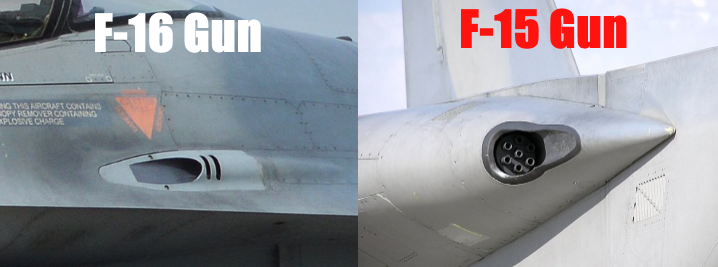
The F-15 can carry a variety of air-to-air weaponry.
Such combinations include AIM-120 advanced medium-range air-to-air missiles, AIM-9L/M Sidewinder missiles, and a 20mm Gatling gun.
The automated weapons system of this aircraft allows the pilot to take part in safe and effective aerial combat while using the heads-up display and avionics and weapons controls located on the engine throttle and control stick.
As the F-15 pilot changes between weapon systems, visual guidance automatically appears on the display.
The F-16 aircraft has 11 hardpoint locations for weapons, including one at each wing tip, three under each wing, and one under the fuselage.
Air-to-air missiles carried on the F-16 will incorporate the new-generation AIM-9X Sidewinder, first fired by the F-16 in April of 2004.
The F-16 air-to-surface missiles include Maverick, HARM, and JASSM missiles, as well as anti-ship missiles.
#7. Dogfight Capability
An aerial dogfight is a battle between fighter aircraft that is conducted at close range.
When the F-15 was being developed, critics were concerned that it was too big and heavy to perform successfully as a dogfighter aircraft.
However, the F-15 has proven to be successful and formidable in the history of fighter aircraft.
In fact, the F-15 has earned over 100 victories in aerial dogfights with zero losses.
An F-15 can fly faster than the G-rating of its airframe, meaning that the aircraft can endure high levels of speed, pressure, and stress.
In addition, the F-15 carries various air-to-air and air-to-surface weapons, including an M61 Vulcan Cannon.
The M61 Vulcan is driven hydraulically, electrically, or pneumatically, with a six-barrel, air-cooled, electrically fired rotary cannon.
It can fire 20mm rounds at an extremely high rate.
The F-16 also features the M61 Vulcan Cannon.
This aircraft, though slightly less powerful than the F-15, is versatile and successful in its dogfight capabilities as well.
The F-16’s ease of maneuverability places it among the superior aerial fighters.
#8. Characteristics
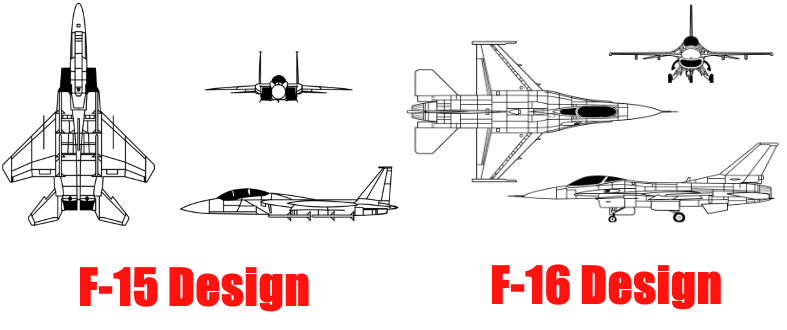
Here are some general characteristics of the F-16 aircraft:
- Primary function is multi-role fighter
- Wingspan is 32 feet, 8 inches
- Length is 49 feet, 5 inches
- Height is 16 feet
- Weight without fuel is 19,700 pounds
- Fuel capacity is 7,000 pounds internal, 12,000 pounds with two external tanks
- Maximum takeoff weight is 37,500 pounds
- Crew for F-16C is one; F-16D is one or two
Here are some general characteristics of the F-15 aircraft:
- Primary function is tactical fighter
- Wingspan is 42.8 feet
- Length is 63.8 feet
- Height is 18.5 feet
- Weight is 31,700 pounds
- Fuel capacity is 36,200 pounds with three external and conformal fuel tanks
- Maximum takeoff weight is 68,000 pounds
- Crew for F-15A/C is one; F-15B/D/E is two
The F-15 aircraft features external fuel pods, allowing it a much longer range than the F-16.
The F-15’s advanced avionics also enhance the aircraft’s ability to pursue enemy aircraft from great distances and in all weather conditions.
In addition, its two-engine design gives it great reliability and allows for flying on just one engine if necessary.
With its one-engine design, the F-16 is more susceptible to engine failure and the accompanying consequences.
However, the F-16 aircraft’s characteristics illustrate that it is smaller, lighter, and easier to maneuver than the F-15.
Furthermore, the F-16 can withstand up to 9-Gs with a full load of internal fuel, exceeding the capability of other fighter aircraft.
Related Article – Navy Pilot Vs. Air Force Pilot
#9. Advantages
Both the F-15 and F-16 have their own individual advantages as fighter aircraft.
Here are the primary advantages of the F-15 aircraft:
- High speed
- High service ceiling
- Long range
- Reliability
- Advanced avionics
- Long distance
- Can operate in bad weather conditions
Here are the primary advantages of the F-16 aircraft:
- Very maneuverable
- Versatile
- Lightweight
- Ease of maintenance
- Less expensive to build and operate
Overall, the F-16 appears less advantageous than the F-15 due to its lower maximum speed, service ceiling, and slower rate of climb.
However, though the F-16 is less powerful than the F-15, it is more maneuverable as a single-engine fighter aircraft.
#10. Mission Use
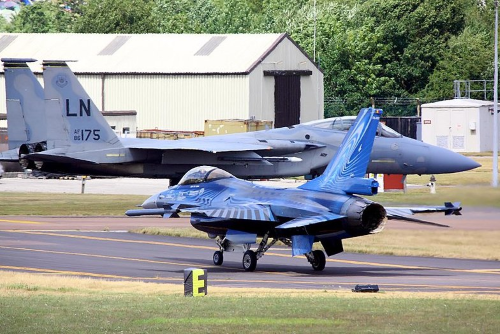
In 1991, F-15C, D, and E models were deployed to the Persian Gulf in support of Operation Desert Storm.
F-15C fighters were responsible for 34 of 37 Air Force air-to-air victories.
F-15E aircraft operated at night in hunting SCUD missile launchers and artillery sites.
F-15 fighters have subsequently been deployed for the following expeditionary force deployments and operations:
- Southern Watch (Iraq)
- Provide Comfort (Turkey)
- Allied Force (Bosnia)
- Enduring Freedom (Afghanistan)
- Iraqi Freedom (Iraq)
The U.S. Air Force also deployed F-16 fighters to the Persian Gulf during Operation Desert Storm in 1991.
They were utilized in attacks on airfields, military production facilities, SCUD missile sites, and other targets.
F-16 multi-role fighters also flew missions during Operation Allied Force with excellent results.
Since the attacks on September 11, 2001, F-16 aircraft have been a primary part of combat forces in the war on terrorism.
They have been flown in numerous missions to support operations Noble Eagle (Homeland Defense), Enduring Freedom (Afghanistan), and Iraqi Freedom (Iraq).
Images
U.S. Air Force Maj. John “Rain” Waters, F-16 Viper
An F-16C Fighting Falcon, 308th Fighter Squadron, Luke AFB, Arizona
F-15C carrying AIM-9X maneuvers into a vertical climb
20181208 Mitsubishi F-15J landing Naha Air Show 2018-57
92-0024 an F-16D Fighting Falcon of 182º Filo Turkish Air Force (4540323888)
McDonnell Douglas F-15 Eagle 3-view
F16 & F15 – RIAT 2010 (4968880958)
- Replacing Dog Tags: 6 Things You Need to Know - June 28, 2024
- Navy OAR Test Study Guide - June 24, 2024
- 10 Best Sniper Movies of all Time - June 20, 2024
Originally posted on July 14, 2022 @ 2:17 am
Affiliate Disclosure: This post may contain affiliate links. If you click and purchase, I may receive a small commission at no extra cost to you. I only recommend products I have personally vetted. Learn more.
